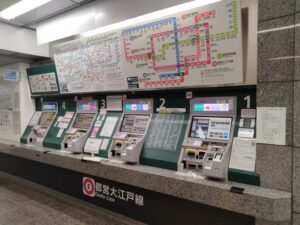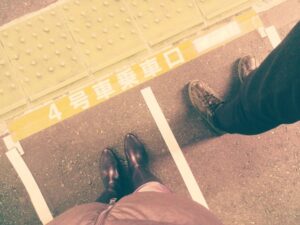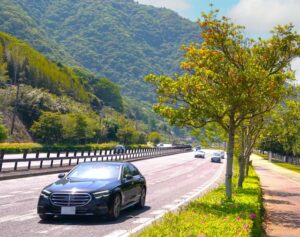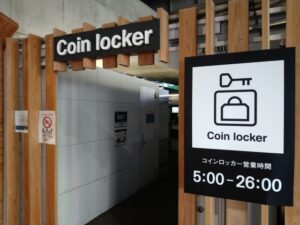Hey, it’s Taka.
I know that when you first look at a Japanese train map, it can feel like staring into a colorful bowl of spaghetti.
But don’t worry.
By the time you finish this guide, you’ll be able to navigate this country as freely as if you were born and raised here.
I’ve poured all the knowledge I’ve gathered over the years, along with all the common pitfalls I’ve seen foreign visitors run into, into this single article.
Let’s master Japan’s transportation together.
Chapter 1: Your Key to Japan – The Absolute Essentials of IC Cards
First things first, let’s talk about your most powerful ally in Japan: the IC card.
Think of it as a magic wand for your trip.
With a simple tap, you can pay for trains, buses, vending machines, and even your morning coffee at a convenience store.
It completely frees you from the hassle of fumbling for coins and buying paper tickets for every single ride.
【Taka’s Advice】The Best Cards for Tourists Right Now
Due to a global semiconductor shortage, the sale of regular, anonymous Suica and PASMO cards has been suspended as of mid-2024.
So for travelers, the best options are the special tourist versions.
- Welcome Suica: This is the tourist version from JR East, featuring a cherry blossom design.
- PASMO PASSPORT: The tourist version from the private railways in Tokyo, with cute Sanrio characters on it.
Functionally, they are almost identical and can be used on nearly all transportation systems across Japan.
Just pick whichever one is available at your arrival airport or major station.
To buy one, you’ll need to show your passport to prove you’re a short-term visitor, and you’ll need cash to load onto it.
One important thing to remember: Unlike the regular cards, these tourist versions are valid for only 28 days, and you cannot get a refund for any remaining balance.
So, my advice is to try and use up all the credit by the end of your trip!
【Taka’s Secret Tips】The Ultimate Hack for iPhone Users
If you have an iPhone, you can take convenience to the next level.
You can add a Suica or PASMO directly to your Apple Wallet.
This means you don’t even need to take a physical card out of your wallet; you just tap your phone on the reader.
You can also recharge it anytime, anywhere, directly from your phone using a credit card.
It’s the ultimate experience in seamless travel.
How to Recharge (Top Up) Your Physical Card
When your balance gets low, you can easily add money at any ticket vending machine in any train station.
The process is simple:
- Look for the “English” button on the screen.
- Insert your IC card into the slot.
- Select “Charge” and choose the amount you want to add.
- Insert cash.
- Take your card back.
It’s that easy.
Chapter 2: The Backbone of Your Trip – Mastering Local Trains & Subways
Now that you have your IC card, let’s conquer the local train and subway systems.
These are the veins and arteries of daily life in Japan.
First, when you get to the platform, look at the electronic display boards.
They will tell you the train’s destination and what type of train it is.
【Common Mistakes】Avoid Wasting Time! Understand Train Types
This is where many travelers get confused and lose precious time.
Not all trains on the same line stop at the same stations.
Here’s a quick breakdown:
- Local (各駅停車 – Kakueki-teisha): Stops at every single station.
- Rapid (快速 – Kaisoku): Skips some of the smaller stations.
- Express (急行 – Kyūkō): Skips even more stations.
- Limited Express (特急 – Tokkyū): Stops only at major hub stations. Often requires a separate express ticket in addition to your base fare.
My advice is to use an app like Google Maps, which will tell you exactly which train type to take.
A Complete Guide to Getting On and Off
At the ticket gate, just tap your IC card on the blue glowing panel and walk through.
On the platform, you’ll notice that Japanese people line up very neatly where the train doors will open.
Find a line and join the back.
Once on the train, there are a few etiquette points I want to share from a local’s perspective.
Keep your conversations quiet and avoid talking on the phone.
If the train is crowded, it’s polite to hold your backpack in front of you or put it on the overhead rack.
And if you see priority seats, please leave them for the elderly, pregnant women, or people with disabilities.
The Last Resort: Buying a Paper Ticket with Cash
If for some reason you don’t have an IC card, you can still buy a paper ticket.
Look for the big fare map above the ticket machines.
Find your current station and then your destination to see the fare.
Then, go to the machine, select the fare amount, insert your cash, and take the ticket.
My most important tip: Do NOT lose this ticket.
You will need it to exit the station at your destination!
The “Fare Adjustment Machine”: Your Savior When You Make a Mistake
If you stay on the train too long or get the fare wrong, don’t panic.
Near the exit gates of every station, you’ll find “Fare Adjustment Machines” (精算機 – Seisan-ki).
Just insert your ticket or IC card, and the machine will tell you how much extra you need to pay.
It’s a lifesaver.
Chapter 3: The Icon of Japan – A Perfect Journey on the Shinkansen (Bullet Train)
Ah, the Shinkansen.
For me, it’s more than just a fast train; it’s a symbol of Japanese efficiency and a truly special travel experience.
The feeling of gliding smoothly and silently through the countryside at incredible speeds is something you have to experience.
【Taka’s Recommended】Booking Your Ticket Online is the Smartest Choice
While you can buy tickets at the station’s “Midori no Madoguchi” (the green ticket office), I’ve seen so many tourists waiting in long lines, looking stressed.
My advice is to book your tickets online in advance.
It’s much easier, you can do it in English, and you can secure your seats without any hassle.
A site like Klook is very user-friendly for this.
Choosing Your Seat: A Breakdown
You have three main choices for seats.
Here’s my take on them:
- Non-Reserved (自由席 – Jiyūseki): Cheaper, but you’re not guaranteed a seat. During busy seasons, you might have to stand. I don’t recommend this for a stress-free trip.
- Reserved (指定席 – Shiteiseki): This is my strong recommendation. For a small extra fee, you get an assigned seat. You can relax knowing your spot is waiting for you.
- Green Car (グリーン車): This is Japan’s version of first class. The seats are wider, there’s more legroom, and it’s a very quiet and luxurious experience. If you want to treat yourself, this is it.
【Taka’s Favorite】Upgrade Your Journey with an “Ekiben”
One of my favorite parts of any Shinkansen trip is the “Ekiben” (駅弁).
These are bento lunch boxes sold at train stations, and they are a huge part of our travel culture.
Each region has its own unique Ekiben featuring local specialties.
Grabbing one before you board and enjoying it while watching the scenery fly by is, for me, the perfect Shinkansen experience.
【Crucial Info】The Oversized Baggage Rule
This is a recent rule that is very important for travelers with large suitcases.
On the major Tokaido, Sanyo, and Kyushu Shinkansen lines, if your luggage has total dimensions (length + width + height) between 161cm and 250cm, you MUST make a reservation for an “oversized baggage” seat in advance.
If you book online, there will be an option to select this type of seat.
【Money-Saving Hack】Is the Japan Rail Pass Worth It?
The Japan Rail Pass (JR Pass) can be an amazing deal, but it’s not for everyone.
It gives you unlimited travel on most JR trains, including the Shinkansen, for a fixed period (7, 14, or 21 days).
Here’s my simple rule of thumb: if you are planning a round-trip between Tokyo and Kyoto within 7 days, the pass will likely pay for itself.
If you add one more major city, like Hiroshima, it’s almost certainly worth it.
If you’re only staying in Tokyo, you don’t need it.
Plan your long-distance travel first, calculate the individual ticket costs, and then compare it to the price of the pass.
Chapter 4: Go Deeper, Save More – Mastering Japan’s Bus Network
While trains are famous, buses are the unsung heroes of Japanese transportation.
They can take you to more local spots and are often the most budget-friendly option.
4-1. City Buses – Exploring Like a True Local
City buses are perfect for exploring areas that train lines don’t reach.
But here’s a tricky part: the way you pay can differ by region.
【Common Mistakes】In Tokyo, you often get on at the front and pay a flat fare immediately.
In cities like Kyoto, you get on at the back, take a small paper ticket (a “seiri-ken”), and pay at the front when you get off based on the number on your ticket.
Always watch what the locals are doing!
Your IC card works on most city buses, which makes it much simpler.
4-2. Highway Buses – The Smart Traveler’s Choice
For long-distance travel, the highway bus is the ultimate money-saver, often costing less than half the price of a Shinkansen ticket.
The “night bus” (夜行バス – yakō basu) is a fantastic hack.
You travel while you sleep, saving on a night’s accommodation and waking up in your next destination.
【Taka’s Advice】For an overnight journey, I strongly recommend booking a “3-row seat.”
It gives you much more personal space and allows you to recline further, which makes a huge difference in comfort.
Chapter 5: When You Need It Most – How to Use Taxis & Ride-Sharing
Sometimes, a taxi is simply the best option, especially when you’re tired, lost, or have heavy luggage.
Hailing a Taxi on the Street
You can usually find taxis waiting outside train stations, or you can hail one on a main street.
Look for the sign on the dashboard.
If it shows the kanji “空車” (kūsha) in red, it’s available.
If it shows “賃走” (chin-sō) in green, it’s occupied.
【Taka’s Experience】Don’t be surprised when the rear left door opens and closes automatically for you.
My foreign friends are always amazed by this!
It’s a signature feature of Japanese taxis.
【Taka’s Secret Tips】Let an App Break the Language Barrier
Explaining a complicated address to a driver in Japanese can be stressful.
That’s why I always recommend using a taxi app.
You can set your destination directly in the app, so there’s no need for a verbal explanation.
It’s foolproof.
The two best apps in Japan are GO and Uber.
GO is the largest local app with more cars, while Uber is familiar to many international visitors.
The Ultimate Solution: Airport Transfers
For getting to and from the airport, especially with heavy bags or a very early/late flight, I highly recommend booking a private airport transfer in advance.
It offers complete peace of mind.
Your driver will be waiting for you, so you can start and end your trip in the most relaxing way possible.
Chapter 6: The Ultimate Freedom – Renting a Car in Japan
This is a topic many guides don’t cover enough, but it can completely change your trip.
While you don’t need a car in big cities like Tokyo or Osaka, renting one gives you incredible freedom to explore rural Japan.
Think about driving through the vast landscapes of Hokkaido, cruising the scenic coastlines of Okinawa, or exploring the Fuji Five Lakes region at your own pace.
What You Absolutely Need: An International Driving Permit (IDP)
This is non-negotiable.
To drive in Japan, you need an International Driving Permit (IDP) issued under the 1949 Geneva Convention.
You must obtain this in your home country *before* you come to Japan.
A simple translation or your home license alone is not enough for most countries.
Key Japanese Driving Rules
- Drive on the left. This is the most important rule to remember.
- Stop completely at all railway crossings. It’s the law.
- Expressways are not free. You’ll pay tolls, which can be expensive.
【Taka’s Advice】Always Rent an ETC Card
When you rent a car, always ask to also rent an “ETC card.”
This is a small card you insert into a device in the car, and it allows you to pass through expressway toll gates without stopping.
The fees are automatically charged to your rental.
It’s a huge time-saver.
【My Recommended Gear】
When you’re navigating unfamiliar roads in Japan, you’ll be relying on your phone’s GPS.
Trust me, you don’t want it sliding around the car.
A solid, reliable phone holder is an absolute must-have for a safe drive.
I personally recommend getting one that clips securely to the air vent or dashboard.
Chapter 7: Other Smart Ways to Get Around
To make this a truly “ultimate” guide, here are a few other options to keep in mind.
7-1. Domestic Flights
If you’re traveling long distances, like from Tokyo to Hokkaido or Okinawa, a domestic flight is often faster and can be surprisingly affordable.
Look into Japan’s Low-Cost Carriers (LCCs) like Peach Aviation or Jetstar Japan.
7-2. Rental Bicycles
For exploring a specific city or town, a rental bicycle is my favorite option.
It’s perfect for cities like Kyoto, Kamakura, or Onomichi.
You can cover more ground than walking but still have the freedom to stop wherever you like.
Many train stations have rental shops nearby.
7-3. Ferries
Japan is a nation of islands, and sometimes the best way to travel is by sea.
Long-distance overnight ferries can be a unique and relaxing experience, connecting major cities like Osaka and Fukuoka.
There are also countless smaller ferries that take you to beautiful remote islands like those in the Seto Inland Sea.
Chapter 8: A Traveler’s Best Friend – How to Use Japan’s Coin Lockers
I want to let you in on a secret weapon for smart travel in Japan: the coin locker.
Imagine this: you’ve just checked out of your hotel, but your flight isn’t until the evening.
Do you drag your heavy suitcase around all day?
Absolutely not.
You find a coin locker.
These are almost always located inside or right outside train stations.
How to Use Them: The Old vs. The New
There are two main types:
- Key-Operated Lockers: The classic style. You put your luggage in, insert the required 100-yen coins, and turn the key. Simple, but you need to have cash on hand.
- Electronic Lockers: The modern, more common type. You place your luggage inside, close the door, and then use a central touchscreen to pay with your IC card (like Suica) or cash. You’ll get a receipt with a PIN code, or your IC card itself becomes the key. It’s incredibly convenient.
【Common Mistakes】What to Do When All Lockers Are Full
At popular stations like Shinjuku or Tokyo Station, finding an empty locker during the day can be a real challenge.
If you’re faced with this, don’t panic.
Look for a “Temporary Luggage Storage” counter (手荷物一時預かり – Tenimotsu Ichiji Azukari).
Many major stations have these staffed counters where you can leave your bags for a fee.
It might cost a little more, but it’s a guaranteed solution.
Chapter 9: Taka’s Final Words & Ultimate Tool-Kit
So, we’ve covered everything from IC cards to coin lockers.
My Must-Have Apps for Travel in Japan
These are the three apps that are always on my phone when I travel in my own country:
- Google Maps: The best all-rounder for train routes, walking directions, and finding places.
- Japan Travel by NAVITIME: Excellent for detailed train schedules, platform numbers, and finding JR Pass-friendly routes.
- Google Translate: The camera function is a lifesaver for reading menus and signs.
My Final Message to You
Japan’s transportation system can seem intimidating from the outside, but I promise you, it’s built on a very logical and user-friendly foundation.
With this guide in your pocket, you are more than prepared.
And if you ever do get truly lost, just find the nearest station attendant, take a deep breath, and say “Sumimasen!” (Excuse me!).
Japanese people are generally very happy to help someone who is trying.
Now, go and have the adventure of a lifetime.










